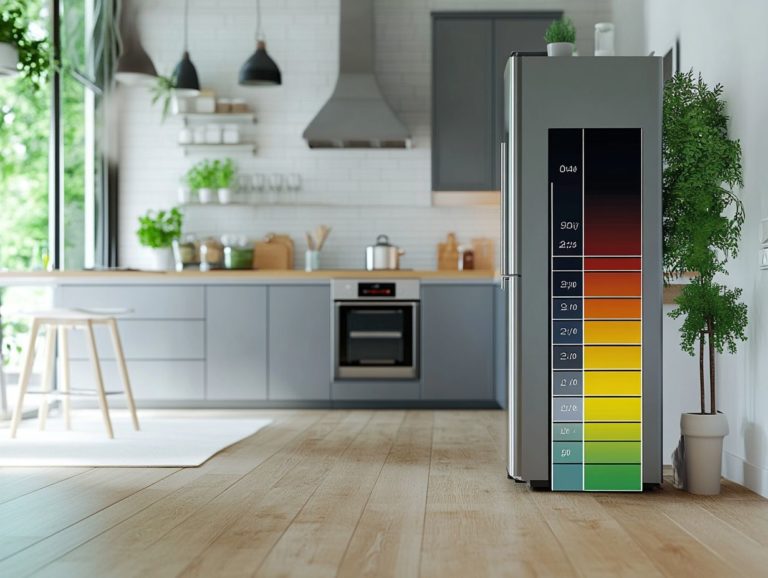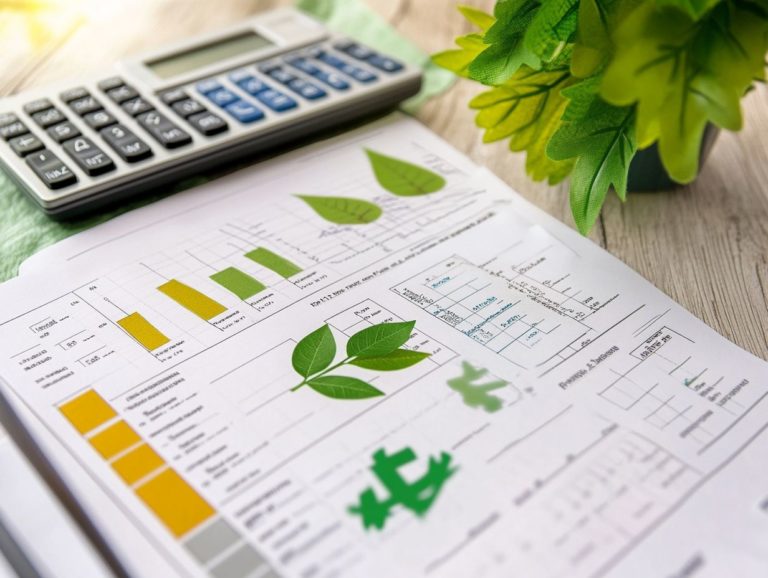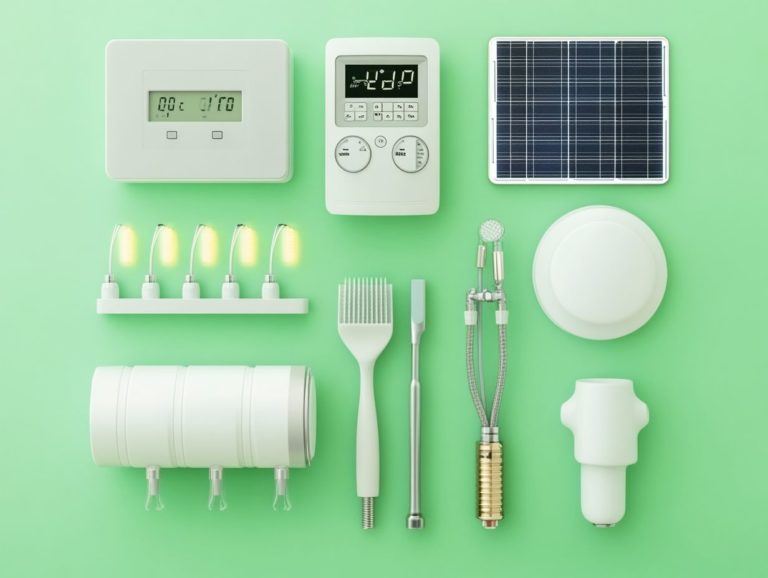5 Essential Energy Audit Tools
In today’s world, optimizing energy use is essential for achieving both cost savings and a positive environmental impact.
Whether you re a homeowner, business owner, or energy professional, equipping yourself with the right tools for energy audits can significantly enhance your efforts.
Get ready to explore five essential tools spanning from power meters to infrared cameras that will assist you in evaluating energy consumption and identifying opportunities for improved efficiency.
You ll discover how these tools operate, their key features, and common pitfalls to sidestep, guiding you toward more intelligent energy management.
Contents
- Key Takeaways:
- 1. Power Meter
- 2. Infrared Camera
- 3. Carbon Monoxide Detector
- 4. Air Flow Meter
- 5. Light Meter
- What is an Energy Audit and Why is It Important?
- How Can These Tools Help with Energy Audits?
- What Are the Key Features to Look for in Energy Audit Tools?
- How Can These Tools Help Identify Energy Efficiency Opportunities?
- What Are the Common Mistakes to Avoid When Using Energy Audit Tools?
- How Can These Tools Help with Energy Savings and Cost Reduction?
- Frequently Asked Questions
- What are the 5 essential energy audit tools?
- Why is a power strip important for an energy check-up?
- What is the purpose of a digital thermometer in an energy check-up?
- How does a light meter help with an energy check-up?
- Why is a thermal imaging camera important for an energy check-up?
- What is the benefit of using an energy monitor in an energy check-up?
Key Takeaways:
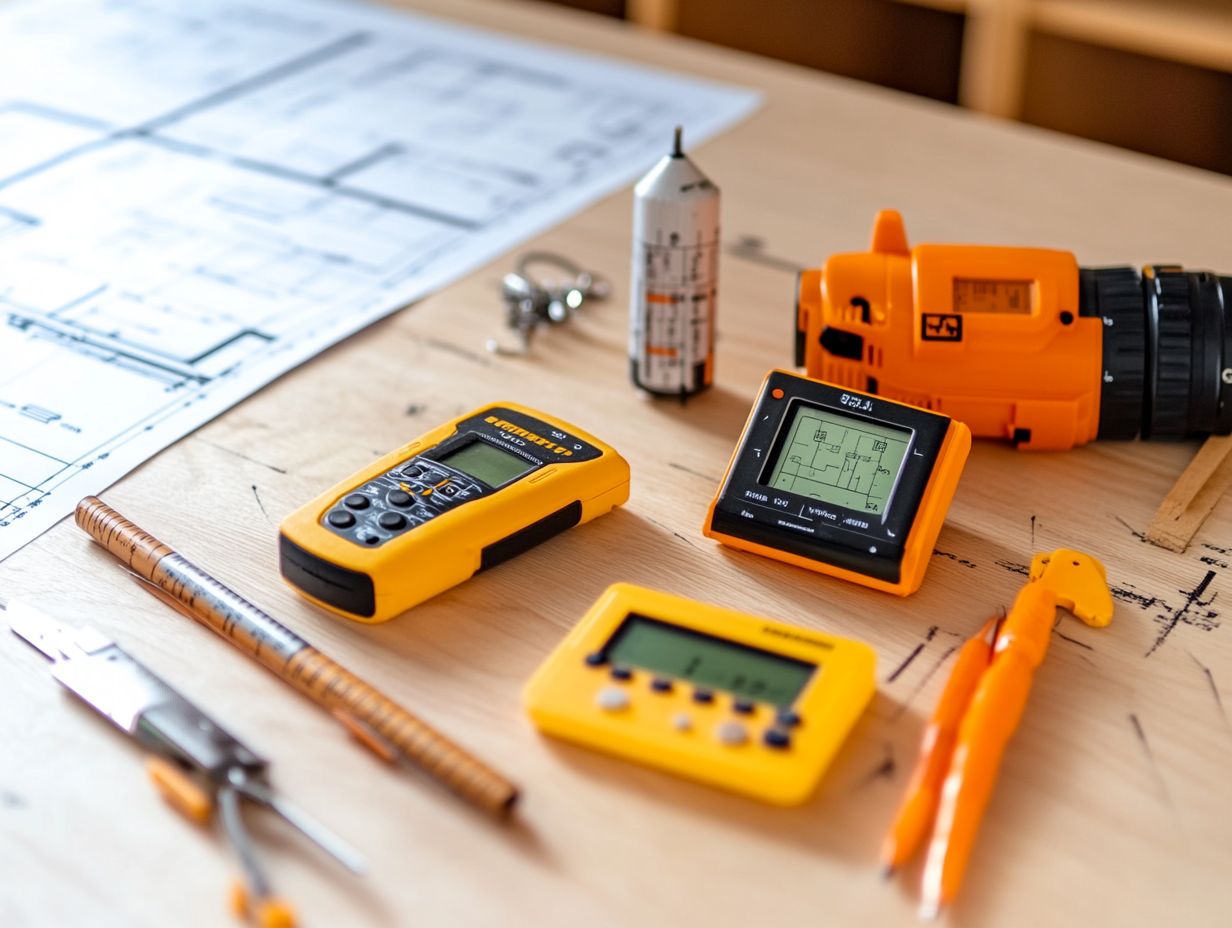
Power meters accurately measure energy consumption and identify areas for potential cost savings.
Infrared cameras detect heat loss, identifying areas for insulation and repair to increase energy efficiency.
Carbon monoxide detectors identify potential hazards and ensure safe air quality for building occupants.
With these tools, you’re equipped to make a real difference in energy efficiency.
1. Power Meter
The Power Meter is an essential tool for energy auditors, offering invaluable insights into electrical measurements and current flow within any system. This device plays a crucial role in enhancing energy efficiency in both residential and commercial environments.
You ll find these meters in various forms, including analog, digital, and smart power meters. Each is designed to measure specific electrical parameters like voltage and current.
Accurate measurements are essential, as they enable you to identify inefficiencies within a system and recommend actionable improvements.
For example, a smart power meter can deliver real-time data, helping you discern peak usage times and pinpoint areas where energy is being wasted. By harnessing this information, you can make informed decisions that lead to reduced energy costs and empower both individuals and businesses alike.
2. Infrared Camera
An infrared camera, like the Flir E5, is truly essential for energy auditors, enabling you to detect heat loss and assess thermal performance with remarkable ease. This method allows you to see heat patterns through innovative, non-invasive technology.
These advanced devices work by capturing infrared radiation emitted from surfaces, allowing you to visualize temperature variations in real-time. This capability is crucial for identifying insulation irregularities, where cooler areas often signal potential air leaks or inadequate insulation.
Thermal imaging is useful in homes and businesses, paving the way for preventive maintenance and energy-saving opportunities.
Don t overlook these important inspections they can save you money and improve comfort today!
3. Carbon Monoxide Detector
A Carbon Monoxide Detector is essential for safeguarding safety during energy audits. It identifies hazardous gases like carbon monoxide that can pose serious health risks to both occupants and auditors.
You’ll find a variety of carbon monoxide detectors on the market, each tailored to meet different environments and user needs. Hardwired models offer reliable, continuous monitoring, while battery-operated versions provide flexibility and portability for mobile auditing teams.
During energy audits, maintaining optimal air quality is critical; poor ventilation can exacerbate CO levels, creating potentially dangerous conditions. By utilizing a portable CO monitor, you significantly enhance your safety protocols, enabling you to swiftly assess air quality and ensure a safer inspection process that prioritizes health and well-being.
4. Air Flow Meter
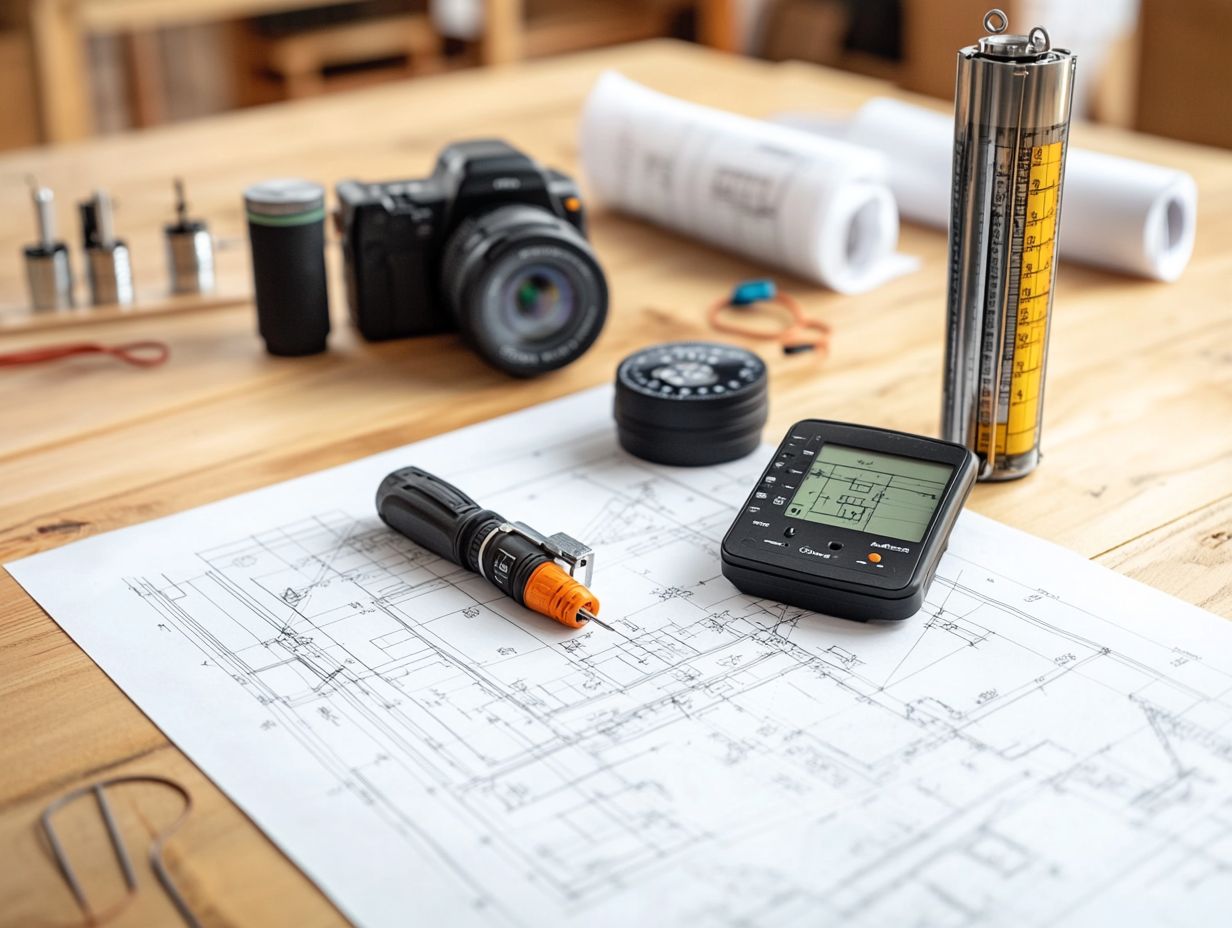
An air flow meter, specifically an anemometer, is essential for accurately measuring airflow in ducts. Measuring airflow is crucial for testing how airtight your ducts are and enhancing energy efficiency during audits.
These devices come in various forms, such as vane anemometers, hot-wire anemometers, and pitot tubes, each suited for specific applications.
- If you’re dealing with larger duct systems, vane anemometers are your best choice due to their robustness.
- Hot-wire anemometers, on the other hand, excel at providing high sensitivity for smaller-scale measurements.
By measuring airflow, these meters enable you to pinpoint inefficiencies in heating, ventilation, and air conditioning (HVAC) systems, like leaks or underperforming components. This detailed check boosts thermal performance and opens doors to energy savings and comfort.
5. Light Meter
A light meter is a key tool for assessing energy efficiency and measuring lighting levels. It helps identify opportunities to optimize energy use in both indoor and outdoor spaces.
By gauging light intensity, you can enhance your lighting designs to improve aesthetic appeal and create a comfortable atmosphere. This is particularly important in workplaces, where productivity often depends on optimal lighting conditions.
When you effectively use a light meter, you can adjust fixtures and layouts to align energy usage with actual needs. This practice reduces unnecessary energy expenses and supports sustainability initiatives by lowering carbon footprints while also boosting job satisfaction and performance.
What is an Energy Audit and Why is It Important?
An energy audit is a thorough assessment of energy consumption and efficiency in your building, carried out by professionals like Chris Mbori. The goal is to find inefficiencies, optimize energy use, and cut costs while minimizing environmental impact.
This assessment serves as a valuable tool for homeowners and business owners alike. It pinpoints specific areas of energy waste and offers actionable recommendations. The process typically includes evaluating your lighting, heating, cooling, and insulation.
Energy audits fall into two main categories: residential, focusing on private homes, and commercial, aimed at larger facilities. Each type involves a systematic evaluation starting with data collection on your current energy use, followed by analyses and a report outlining potential improvements.
Engaging in these audits leads to significant cost savings and enhances energy efficiency while improving comfort in your space.
How Can These Tools Help with Energy Audits?
Energy auditing tools are crucial for improving the efficiency and accuracy of your audits. They provide essential data on electrical systems, airflow, and thermal performance, especially when you consider the 5 key considerations for energy audits.
Tools like infrared thermometers, energy management software, and flow meters gather extensive data, revealing how energy is consumed and wasted in your facility. For example, infrared thermometers identify temperature inconsistencies around insulation and ductwork, highlighting areas needing sealing or improvements. To enhance your energy efficiency further, consider consulting 5 local experts for energy audits.
Energy management software analyzes historical consumption trends and identifies peak usage times, offering insights for potential energy-saving strategies. Flow meters measure air movement, allowing adjustments that significantly enhance ventilation efficiency.
When combined, these functionalities enable you to create comprehensive recommendations that lower energy costs and support sustainability. Act now for a greener future!
What Are the Key Features to Look for in Energy Audit Tools?
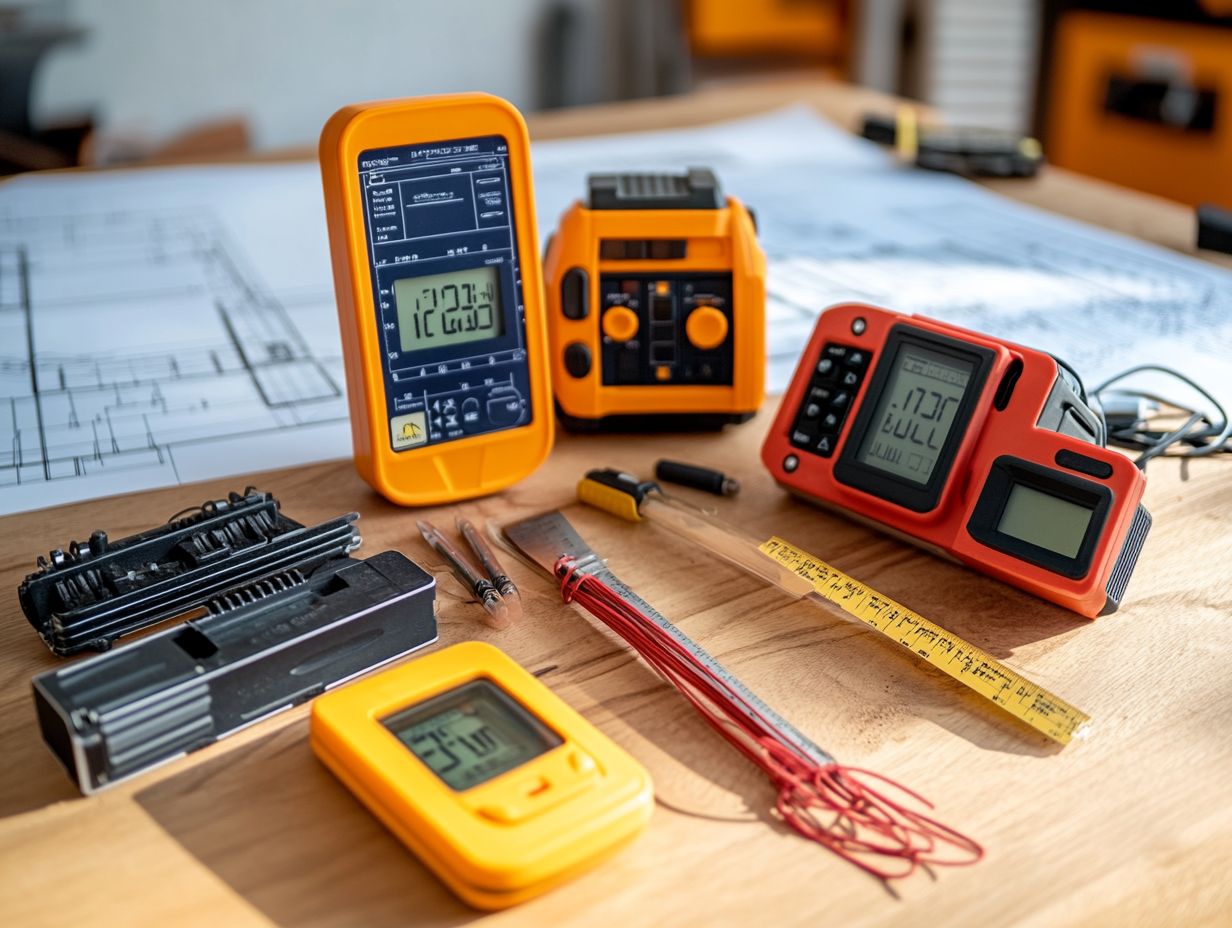
When selecting energy auditing tools, consider key features such as accuracy, ease of use, and versatility. To maximize your efforts, explore 5 ways to prepare for an energy audit. These features help you achieve your energy efficiency goals.
Measurement precision is crucial. Any discrepancies can lead to misleading conclusions about your energy consumption patterns. Portability is also important, allowing for easy transport across various sites.
Compatibility with other devices improves your audit process. It facilitates seamless data integration and analysis. By focusing on these features, you streamline your auditing process and enhance the effectiveness of your recommendations for improving energy efficiency.
How Can These Tools Help Identify Energy Efficiency Opportunities?
Energy auditing tools help uncover energy efficiency opportunities by analyzing electrical parameters and consumption patterns. This analysis highlights areas for improvement and potential cost savings, including innovative solutions from energy audits.
By examining these elements, you’ll spot trends, such as excessive energy use during peak hours or unusual spikes that may signal equipment issues. These tools can also identify areas vulnerable to heat loss, like poorly insulated walls or drafty windows.
For instance, sealing gaps in insulation or replacing outdated windows can lead to significant reductions in heating and cooling costs. These actionable insights encourage you to take proactive measures that enhance energy efficiency and promote long-term sustainability.
What Are the Common Mistakes to Avoid When Using Energy Audit Tools?
Common mistakes when using energy audit tools can undermine your audit’s effectiveness. Issues may arise from incorrect measurements or overlooking critical electrical parameters.
Inexperienced auditors often neglect proper tool calibration, resulting in inaccurate readings that skew data analysis. Misinterpreting collected data can lead to misguided recommendations that fail to address the core issues of energy inefficiency.
Never underestimate the importance of safety protocols. Neglecting Personal Protective Equipment (PPE) can expose you to hazards, compromising your safety and the integrity of the audit process.
It s crucial to familiarize yourself with correct procedures and industry standards to ensure safe and effective assessments.
How Can These Tools Help with Energy Savings and Cost Reduction?
Advanced energy auditing tools can enhance your energy savings and reduce costs by highlighting inefficiencies and offering 5 tips for energy audit success to optimize energy consumption.
These tools, from thermal imaging to smart meters, empower you with a comprehensive understanding of your energy usage patterns.
For example, a manufacturing facility in Ohio conducted an energy audit and uncovered outdated machinery that consumed excessive power. By upgrading to energy-efficient models, the company reduced its annual energy costs by 30% while boosting production efficiency.
Similarly, a community housing project in California used energy audits to install energy-efficient lighting and HVAC systems, achieving a remarkable 25% reduction in utility bills.
These case studies show how targeted interventions from precise energy audits can yield substantial financial and environmental benefits.
Frequently Asked Questions
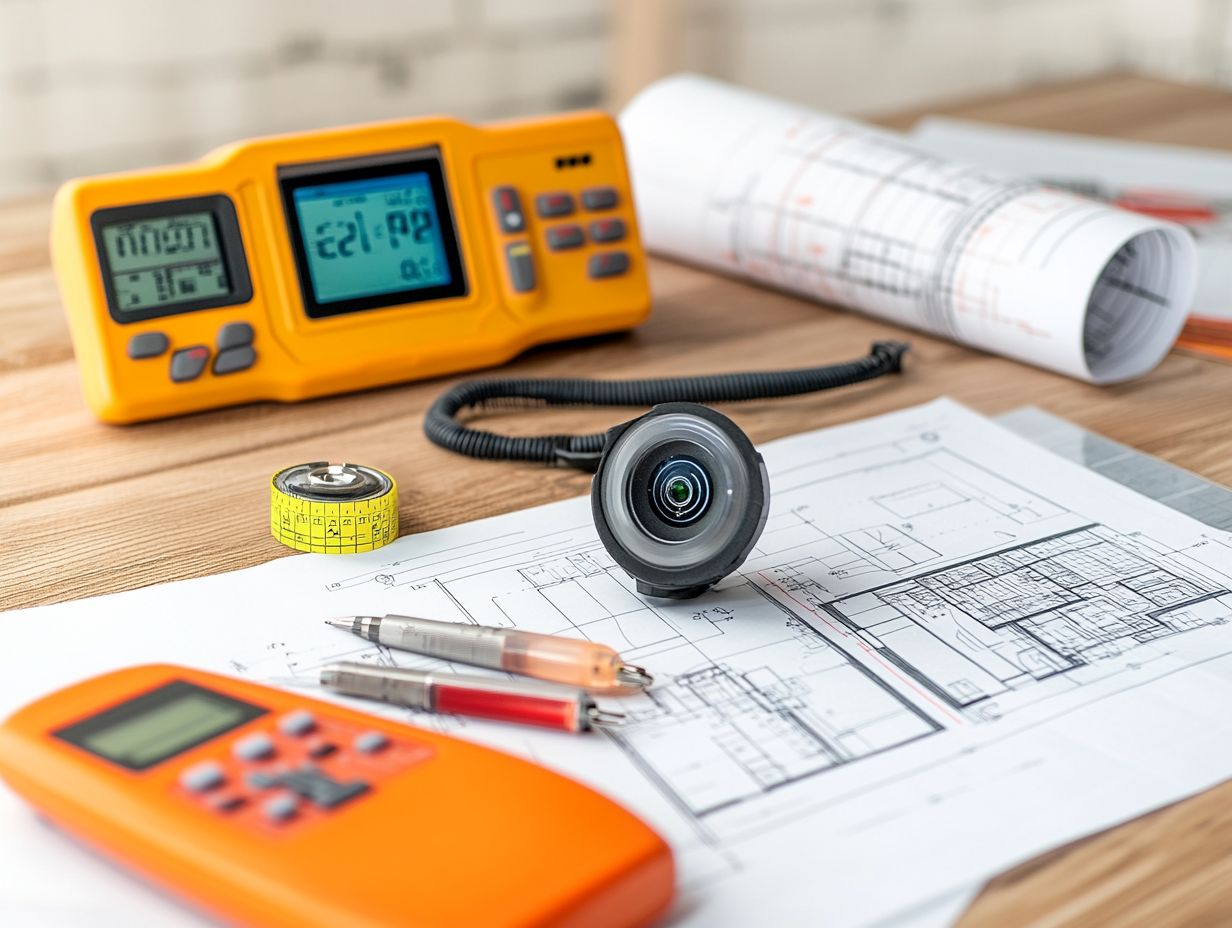
What are the 5 essential energy audit tools?
The 5 essential tools for energy auditors are: a power strip, a digital thermometer, a light meter, a thermal imaging camera, and an energy monitor.
Start your energy audit today to uncover savings!
Why is a power strip important for an energy check-up?
A power strip helps you monitor and control the energy usage of multiple devices. This makes it easier to spot where energy is wasted.
What is the purpose of a digital thermometer in an energy check-up?
A digital thermometer measures temperatures in various building areas. This helps identify spots where energy may be leaking out.
How does a light meter help with an energy check-up?
A light meter checks the light levels in a room. It shows where you can improve energy efficiency, like using natural light or switching to LED bulbs.
Why is a thermal imaging camera important for an energy check-up?
A thermal imaging camera identifies temperature differences. It finds air leaks or poor insulation, which can lead to energy loss.
What is the benefit of using an energy monitor in an energy check-up?
An energy monitor tracks real-time energy usage. This helps you spot areas for savings and manage energy more efficiently.

